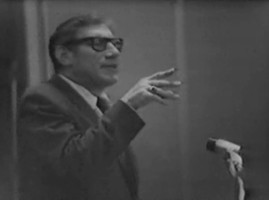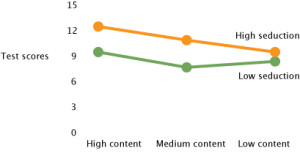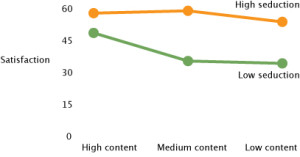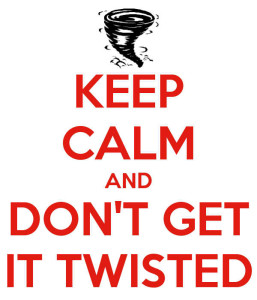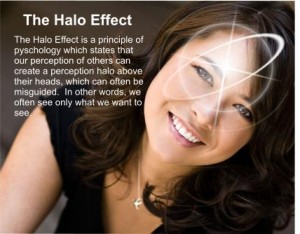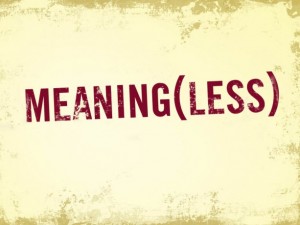Originally published December 12, 2013
It’s no secret that as humans we disagree on just about everything from politics to proper personal training practices. However, we all share the exact same desire, which is to have as few false beliefs as possible, and as many true beliefs as possible. In other words, we all want our views and practices to lawfully align with reality.
One of the problems is that some people are using reliable epistemological processes (i.e. ways of knowing) while others are using less reliable epistemic processes. And, as I addressed in my Evil Sugar Radio podcast on How to Detect B.S., unreliable epistemologies are more likely to lead to unreliable conclusions. The other problem is that being human means being fallible – your favorite fitness “experts” are just as fallible as you are. So regardless of how smart we are, the body of science done in the social psychology arena has shown us a Baskin-Robins variety of cognitive bias, heuristics, and logical fallacies that not only cause us ALL to misjudge the evidence of our own experiences, but also cause us to often form false beliefs and then reinforce them as true.
The purpose of this Why Smart Trainers Believe Stupid Things (WSTBST) series, as I said in my first installment to this series covering the Bias Toward Positive Evidence, is to help fitness professionals recognize these non-negotibale psychological realities, and overcome them in order to arrive at more sound judgments, and more valid beliefs about your personal training practices. (And about everything else in life, as our beliefs inlfuence our actions.)
Duped by the Dr. Fox Effect!
Today’s installment of my WSTBST series focuses on the Dr. Fox effect, a phenomenon in which the style of a lecture can impress even sophisticated learners, and trick them into mistaking meaningless content for education of actual substance. This comes from a classic and eye opening series of studies investigating the Dr. Fox effect. (Naftulin et al., 1973; Williams and Ware, 1975, 1976).
In the first Dr. Fox experiment (done in 1973) the researchers hired an actor to pose as an expert (Dr. Fox) and deliver a lecture on game theory to a group of true experts on the subject. “Dr. Fox” who was billed as an “authority” on the “application of mathematics to human behavior” and his lecture was given an impressive title: “Mathematical Game Theory as Applied to Physician Education.”
The actor (Dr. Fox) was trained only one day prior to giving lecture, which, although his lecture was loosely based on the 1962 Scientific American article by American mathematical psychologist Anatol Rapoport, “The Use and Misuse of Game Theory;” the lecture intentionally prevented him from saying anything meaningful. In other words, the day before, the actor and researchers worked up an absolutely meaningless, but entertaining lecture full of complex sounding jargon, useless analogies, jokes, incomprehensible jabbering, and excessive double talk.
The authors hypothesized that given a sufficiently impressive lecture paradigm, even experienced educators participating in a new learning experience can be seduced into feeling satisfied that they have learned despite irrelevant, conflicting, and meaningless content conveyed by the lecturer.
The actor (Dr. Fox) was very worried that he’d be exposed by the actual experts on game theory who were his audience. But after the 20-minutes-long talk was over, the audience bombarded him with questions, which he also answered, and still nobody noticed. Not to mention, the audience gave “Dr. Fox” high ratings on a post-lecture evaluation form. All ten people who attended the lecture said that it had given them food for thought, while nine of them said that Dr.Fox had presented the material in a clear, well-organized manner that incorporated plenty of good illustrative examples into his talk.
These results confirm the hypothesis that the audience members were seduced into believing a meaningless lecture gave them meaningful information. And, given their level of academic achievement, this (false) impression was not due to a lack of intelligence or knowledge of the subject matter.
This video shows you clips of the actual Dr. Fox lecture interspersed with a summary of the study:
If you’re curious to watch it, this is a video of the entire Dr. Fox lecture:
The Second, and Much Better Dr. Fox Study
As interesting as the above results are, the first Dr. Fox experiment was poorly designed, as it involved a very small audience, there was no control lecture to compare to, and there were no student achievement tests given afterward. Knowing this, the researchers did conduct more controlled experiments on larger audiences.
The second (1975) Dr. Fox experiment was randomized and controlled, and it included student achievement tests, which allows us to draw more meaningful conclusions about the influence of “seduction” in the teaching arena.
In the second Dr. Fox study:
Two hundred seven undergraduate and graduate students were randomly assigned to six groups. Each group watched a different 20-minute videotaped lecture (by the same Dr. Fox actor from the earlier study) on the biochemistry of memory.
- Two groups watched lectures that covered 26 teaching points.
- Two groups watched lectures containing a subset of 14 teaching points.
- Two groups watched lectures containing an even smaller subset of 4 teaching points.
The six lectures varied in both substance and style.
 Substance-wise: In the lower-content (14-teaching point and 4-teaching point) lectures, the void left by the removed teaching points was filled in with meaningless blather, nonsense, and unrelated details.
Substance-wise: In the lower-content (14-teaching point and 4-teaching point) lectures, the void left by the removed teaching points was filled in with meaningless blather, nonsense, and unrelated details.
Style-wise: In the high, medium, and low content lectures (26, 14, and four teaching points) the actor delivered one of the lectures in a seductive manner, and delivered the other lecture without seduction. The high seduction lecture behaviors included enthusiasm, humor, friendliness, expressiveness, charisma, and personality. The seduction-free lectures were absent of these characteristics.
Following the lecture, each student took a test on the teaching points covered in the lecture they watched, and were also given a standard course evaluation form to rate their satisfaction. As you’re about to see, both content coverage (i.e. substance) and presentation style both influenced student learning.
Here are the results from the student achievement test:
(Note: the two charts provide below are taken from this post by Jon Herron)
As the above chart displays, students who watched lectures featuring more teaching points scored better on the test. And, students who watched lectures delivered in a more seductive manner also scored better. That said, it’s important to note that the style of the presentation had a greater impact in student performance than did content substance.
Here are the results from the student evaluations:
As you can see by the chart above, students gave better reviews for lectures featuring more substantive content, and for lectures delivered in a more entertaining (i.e. higher seduction) fashion.
In his article on the same subject, Jon Herron summarizes these results nicely:
“Content coverage influenced student satisfaction only when the lecturer lacked personality. When the lecturer was warm and entertaining, the students were highly satisfied regardless of how much material he was actually giving them. Consistent with the first Dr. Fox paper, charisma can fool students into giving instructors with poor command of their subject matter higher marks than they deserve. But a general preference among students for teachers with appealing personalities is likely justified. That’s because, all else being equal, when students take classes from appealing teachers they learn more.”
The Dr. Fox Effect in Fitness Education
I feel there are two main take away points – overall take-home points are at the conclusion of this article – from the above study results that directly impact the fitness education arena:
1. If you wish to become a fitness educator (i.e. train the trainers) or already teach fitness education courses; teaching (any subject) is much more effective when it’s done in a “seductive” manner that includes enthusiasm, humor, friendliness, expressiveness, charisma, and personality.
So, talking about why smart trainers belief stupid things: It’s foolish to believe that fitness professionals will benefit most from simply going over a bunch of scientific studies. Sure you want to go over the science since training is the art of applying the science, but you’ve got to deliver it in a manner thats entertaining and engaging.
2. As a fitness educator (or a teacher in any other field), you don’t necessarily have to provide good information, you just have to put on a good show, and people (just like you and me) will not only like you and perceive you as an “expert,” they’ll also believe that you’ve provided them a substantial educational experience.
In other words, the Dr. Fox Effect is very real, and it applies to well-educated adults and to students. And, it’s foolish to believe that you have not been (and won’t be) duped by the Dr. Fox effect.
Now, no one is saying that there are fitness educators out there intentionally spouting nonsense – I’m not talking about marketers with informercials and “Six pack abs” type products. What I am saying is that just because a fitness educator is popular and generaly thought to provide valuable information is no indication of the actual substance of the information they do actually provide. In fact, in the original (1973) Dr. Fox paper, the authors mentioned one study (5) in which 1,427 students regarded “teacher charisma or popularity” as the most important characteristic when rating teachers. The article further states that “students do not respond directly to specific questions regarding teacher effectiveness. Rather a kind of halo effect on teacher charisma or popularity determines to a large extent how students react to questions about their teacher.”
Deepities and the Dr. Fox Effect
In addition to charisma, deepities – a term coined by philosopher and author Daniel Dennett – are a way we can be fooled into believing we’ve learned something meaningful when it’s actually trivial or meaningless.
According to Rational Wiki, a Deeptiy refers to a statement that is apparently profound but actually asserts a triviality on one level and something meaningless or false on another.
There are deepties in all walks of life – I’ll cover two prevalent deepities in the fitness field in a moment. Here are two great examples of deepities taken from Rational Wiki, which you’re certainly familiar with and have probably said:
“Everything happens for a reason” – OK, so the bridge collapsed because the supports finally gave out, that’s a reason. But the implication is that it happened to some purpose, and that’s just false.
“Love is just a word” – ”Love” is just a word. “Apple” is just a word too, but you can’t eat the word “apple”, while you can eat an apple. Another use/mention distinction failure.
As philosopher and author Dr. Peter Boghossian says, “one could easily fill an entire book with deepities, and many authors like Deepak Chopra have, as virtually every statement he makes (like the two below) is a deepity:
“The universe exists in awareness alone”
”All material objects are forms of awareness within awareness, sensations, images, feelings, thoughts”
My Favorite Fitness Trainer Deepity
 The professional fitness training field has it’s own deepities, my favorite being “don’t add fitness to dysfunction.” This statement is a deepity, as on one level it’s trivially true because we certainly don’t want our training recommendation to promote problems.
The professional fitness training field has it’s own deepities, my favorite being “don’t add fitness to dysfunction.” This statement is a deepity, as on one level it’s trivially true because we certainly don’t want our training recommendation to promote problems.
And, on another level this statement is meaningless because it describes doing the most basic part of the job of all fitness professionals, which is to avoid giving our clients exercises that cause them pain and avoid allowing them to do exercises or use loads they can’t display good control and technique on. Also, an argument can be made that this statement is false, because aside from the evidence showing a knee valgus collapse (upon drop landing) as a strong predictor of future non-contact ACL injury risk in female athletes (6); the body of reserach looking at the Postural-Structural-Biomechanical (PSB) shows that generally what has been hypothesized to be “dysfunctions” seem to simply be variations of normal. (7) (Note: To get into the details of the evidence and debates in this arena is far beyond the scope of this post)
“If you’re not assessing you’re guessing” is another popular personal trainer deepity (closely related to the one I just covered above). In this video I address why this saying is also big on style, but little in substance:
What is important to note is that deepities offer a very vague meaning, which makes them ripe for subjective validation. Subjective validation describes the fact that we are prone to believing vague statements, especially if we feel they address us personally. In other words, if a statement is ambiguous and you think it addresses you directly, you will boil away the ambiguity by finding ways to match it up with your own unique situation, experiences, etc. And, since “don’t add fitness dysfunction” vaguely describes the basic job of every personal trainer, this perfectly explains why many fitness professionals feel this deepity offers them and their colleagues something profound and meaningful.
Additionally, it’s also important to note that the use of a deepity, as Peter Boghossian says, “is often a transparent attempt to evade criticism, as malleable definitions allow us to slip away from critique by keeping the door open to say that all the criticisms you’ve offered are incorrect and that you just don’t understand what they’re trying to say.”
Deepities not only allow leaders to slip away from criticism; they also allow them to attract more followers. In that, we gravitate towards people (leaders) who seem to have access to secrets and great insights; these leaders seem to have things figured out, and we want to figure those things out, too. And, when we can’t seem to pinpoint a clear definition of what they’re saying, we feel that this person holds truths that are beyond our comprehension, and we follow them around hoping some of their mojo will eventually rub off on us. (This is one of the ways “gurus” are made.)
Take Away Points for Fitness Trainers and Fitness Educators
The reality is we can’t ensure that we’ll never fall prey to the Dr. Fox effect, but we can use our knowledge of its power to be less stupid. In other words, we can recognize that the Dr. Fox effect exists and do our best to overcome its effects with the simple strategies I’ve described below:
– As a Fitness professional, ask yourself: Is this teacher trying to do something TO me, or are they trying to do something FOR me? And, one of the ways to tell the difference is the use of inflated language and special jargon. As Scott Berkun discusses in his How to Detect Bullshit post, “jargon and obfuscation hide huge quantities of BS. Inflated language is a technique of intimidation. The bet is that if you don’t understand what they’re talking about, you’ll feel stupid, or distracted, and give in to the appearance of their superior knowledge. This is, of course, entirely bullshit.”
Additionally, in his Why Jargon Feeds On Lazy Minds post, Berkun talks about how the use of unclear language and special jargon is done by “those who want to be perceived as the best and the brightest, something they know they are not. They use cheap language tricks to intimidate, distract, and confuse, hoping to sneak past those afraid to ask what they really mean.”
– With the above in mind; as a fitness educator (current or aspiring), ask yourself: Am I just trying to impress people, or I am trying to expose them to the concepts and techniques I feel to be important, in an simple and easy to understand manner that they can immediately use on their own?
Also, ask yourself: Am I my trying to convince these people that I am right (and everyone else who disagrees with me is wrong), or am I simply interested in sharing my experiences and values so they can understand my perspectives on things, and decide for themselves who’s more likely come to accurate conclusions?
Remember: Never use a fancy (special) word when a simpler (generally used) one will do. The words we use are important, as they can help us see clearly, or they can confuse, cloud, or obscure issues.
– As a Fitness professional, ask yourself: How does this change my training? If an educational experience has truly offered you substance (not just style), it will directly and immediately impact the way you train, or the way you think about your training. In that, a meaningful educational experience will provide you with new concepts and techniques to use; provide good evidence as to why you may no longer need to use certain concepts and techniques that you may be currently using; help you to refine your applications of certain concepts and techniques you are already using, etc.
Asking yourself these questions will sometimes reveal an unfortunate reality that although you may have felt like a given educational experience was beneficial, in reality you’re left feeling as if you need to attend the speaker’s intensive courses or must buy their products in order to truly “understand” what they were teaching in the class you just attended.
Put simply, you should want to pursue further (more intensive) education with a given speaker, or wish to buy their products ONLY because you’ve found that they indeed deliver lots of meaningful substance, NOT because you were impressed with their vast knowledge, and left feeling unclear because what they were talking about was “over your head.”
– As a fitness educator, ask yourself: What do I want the students to take away from this class?
Also, ask yourself: Is there a simpler, more direct way that I can convey this message to ensure the students will be able to take away from this class when I want them to?
Additionally, ask yourself: Am I offering the students the most value for their time and financial investment? How could I offer them more value?
In Summary: You don’t want to leave a class thinking “wow, that instructor was really smart and I don’t know anything compared to that person” – that’s doing something TO you. Instead, you want to leave a class thinking, “wow, that instructor really gave me lots of things that directly change my training beliefs and practices” – that’s doing something FOR you.
Also, when evaluating the value of an educational experience, make an effort to keep the appearance, demeanor or fame of the teacher separate. In other words, make sure the teacher is anonymous during your final evaluation of the substance (if any) of the information they provided. The more you can force the information provided to stand on its own, the less likely you are to fall prey to the Dr. Fox effect. And, when you combine that will the critical thinking and B.S. Detection skills I covered in my Evil Sugar Radio podcast, you’ll be far less likely to be a smart trainer who believes stupid things.
Science (Nerd) References:
1. Naftulin, D., J.E. Ware, Jr., and F.A. Donnelly, 1973. “The Doctor Fox Lecture: A Paradigm of Educational Seduction”, Journal of Medical Education 48: 630-635.
2. 1962, “The Use and Misuse of Game Theory”, in: Scientific American, 207: 108-114.
3. Williams, R., and J. Ware, 1975, “The Dr. Fox effect: a study of lecturer effectiveness and ratings of instruction,” Journal of Medical Education 50: 149-156.
4. Williams, R., and J. Ware, 1976, “Validity of student ratings of instruction under different incentive conditions: A further study of the Dr. Fox effect”, Journal of Educational Psychology 68: 48–56.
5. Coats, W. D., and Swierenga, L. Student Perceptions of Teachers. A Factor Analytic Study. J. Educ. Res., 65:357-36, April, 1972.
6. Quatman CE, et al. The anterior cruciate ligament injury controversy: is “valgus collapse” a sex-specific mechanism? Br J Sports Med. 2009 May;43(5):328-35.
7. Eyal Lederman, PhD. The fall of the postural-structural-biomechanical model in manual and physical therapies: Exemplified by lower back pain. Journal of Bodywork and Movement Therapies. Volume 15, Issue 2 , Pages 131-138, April 2011
__________________________________________________________________________________________________________
Coach Nick Tumminello is the owner of Performance University International, which provides hybrid strength training and conditioning for athletes and professional educational programs for trainers and coaches all over the world.
As an educator, Coach Nick has become known as the Trainer of Trainers. He has presented at international fitness conferences in Iceland, China, and Canada. He has been a featured presenter at conferences held by such organizations as IDEA, NSCA, DCAC, and ECA, along with teaching staff trainings at fitness clubs throughout the United States. Nick holds workshops and mentorship programs in his hometown of Fort Lauderdale, Florida. He has produced more than 15 instructional DVDs and is a CEC provider for ACE and NASM.
Nick has been a fitness professional since 1998 and co-owned a private training center in Baltimore, Maryland, from 2001 to 2011. He has worked with a variety of exercise enthusiasts of all ages and fitness levels, including physique and performance athletes from the amateur to the professional ranks. From 2002 to 2011, Nick served as the strength and conditioning coach for the Ground Control MMA fight team and as is a consultant and expert for clothing and equipment companies such as Sorinex, Dynamax, Hylete, and Reebok.
Nick’s articles have appeared in over 30 major health and fitness magazines, includingMen’s Health, Men’s Fitness, Oxygen, Muscle Mag, Fitness RX, Sweat RX, Status, Train Hard Fight Easy, Fighters Only, and Fight! Nick is also a featured contributor to several popular fitness training websites. He has been featured in two New York Timesbest-selling exercise books, on the front page of Yahoo.com and Youtube.com, and in the ACE Personal Trainer Manual, Fourth Edition. Nick’s new book, Strength Training for Fat Loss, will be available March 25th 2014.

